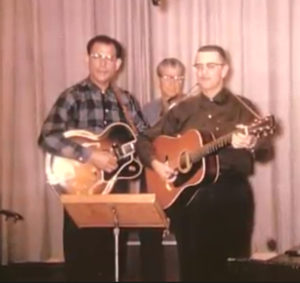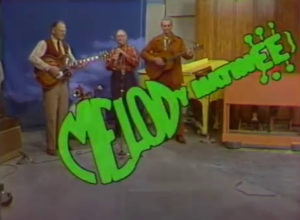
Our local TV stations had lots of time to fill when the networks weren’t broadcasting. There were blocks for the station’s choice of what to show that would run from 12:00 noon and 1:00 PM (central time). Another break came between 3:00 PM and 5:30 PM each day. There was also an hour available between 6:00 and 7:00 PM each weeknight. Saturday nights, when network news was not broadcast, the time would stretch between the end of whatever sporting event was shown (about 5:00 PM or so) and 7:00, when the evening’s network shows began.
The stations I grew up with, KODE channel 12 out of Joplin, and KOAM channel 7 out of Pittsburg, Kansas, filled much of the free time with local music shows.
In the mid-south, where I grew up, the primary television demographic was the thirty-to-forty-year-old male. I’m not sure why, but it seemed that most local shows were aimed at that particular audience. I’m guessing that this was because program managers were males aged in their thirties and forties. They grew up listening to local musicians on the radio, and the genre transferred easily to the black and white screen.

Anyhow, the results were shows like Melody Matinee, broadcast every weekday at 12:30, right after the local noon news broadcast. Melody Matinee consisted of three musicians, Virgil and Earl on guitars, and a lady whose name escapes me who was a whiz on the Hammond organ. All three sang, as I recall, belting out classics right out of Oh Brother, Where Art Thou? long before they were considered cool.
Kids would roll their eyes as our Depression-era parents would listen to the extremely tame (in our minds) renditions of songs that might be a hundred or more years old. I guess I know how my son feels when I get teary-eyed over Neil Young’s Powderfinger.
Melody Matinee ran for many years, originating in the 50’s and finally being retired around 1981.
Another local show, specializing in country music, was the Happy Jack and Helen show, broadcast from downtown Joplin. I believe it was Cope’s Fine Carpets that sponsored the half-hour, meaning every commercial break was given to them. The show featured lots of picking and singing, and I’m sure it had a goofy guy in ill-fitting overalls to provide comic relief, as did every single local or national C&W TV show of the time.
But the teenaged demographic was courted, as well. KODE broadcast Teen Hop on Saturday afternoons between noon and 1:00. The show featured teenaged couples from the area competing in dancing with Top Forty hits being played. The winners would get a $20 gift certificate or something similar.
The homegrown music shows were low-budget, laid back fun. And I’m sure, if you pored over the few (if any) remaining videotapes, you could probably spot future famous musicians among the local talent. But irregardless, I feel like the passing of local music shows filmed in nearby downtown buildings is one more sign that we Baby Boomers just might not stay eternally young like we were sure we would.
Vie Clark on the Hammond Organ.